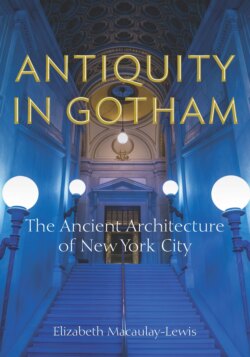Читать книгу Antiquity in Gotham - Elizabeth Macaulay-Lewis - Страница 18
TWO The Genius of Architecture: Ancient Muses and Modern Forms
ОглавлениеThere is no walk of the elegant arts in which our defects in science and taste are more palpable than in that of architecture.… The Genius of architecture seems to have shed her maledictions over this land.
—GULIAN VERPLANCK
Gulian Verplanck’s 1824 address1 to the American Academy of Fine Arts in New York must have hit a nerve. The United States and arguably its most prominent city, New York, was a wasteland, with “short-lived” architecture that would “scarcely outlast their founders.”2 A cultured European who had come to experience the American democratic experiment firsthand would view “the general taste and character of public edifices … with disappointment.”3 The genius—an ancient personification or spirit—of architecture had not graced New Yorkers with its inspiration.
From the “ignorant present,” New York would need to develop its own architecture.4 Verplanck, an attorney, politician, and writer, argued that the most effective way of elevating the United States’ reputation abroad was through “the grandeur or beauty of [its] public structures.”5 Given its capacity as the United States’ primary entrepôt, New York needed outstanding public—that is, civic, judiciary, and administrative—architecture.
Verplanck was explicit about the United States’ current architectural failings, but he also offered a solution: “We have borrowed most of it from France and England, and by no means from the best models which these countries afford; it is only within a very few years that we have begun to think for ourselves, or draw directly from the purer fountains of antiquity.”6 American architects needed to reject European models, including Palladian architecture, which he detested, declaring it “that corruption of the Roman … which delights in great profusion of unmeaning ornament.”7 Rather, American architects should go directly to the ancient source, which offered the best models for the new nation’s architectural requirements. He mused:
The ancient legislators understood the force of such principles well. In the mind of an Ancient Greek, the history of his country, her solemn festivals, her national rites, her legislation, her justice, were indissolubly combined with the images of everything that was beautiful or sublime in art. Every scholar knows, too, how much the remembrance of the Capitolii Arx alta, the lofty majesty of the capitol, entered into every sentiment of love and veneration, which the Roman citizen, when Rome was free, entertained for his native city.8
Good public architecture did not merely reflect the ideals of the new nation or impress European visitors; it also forged social cohesion. Architecture, Verplanck opined, allowed the poor man “to forget the comparative hardships of his lot, and to feel a more real and palpable community of interest with his wealthy neighbour.”9 This idea foreshadows the ideals of the City Beautiful movement, discussed below in the context of Foley Square,10 and the use of architecture and monuments by patrician New Yorkers to educate and assimilate new immigrants in the late nineteenth and early twentieth centuries (discussed in Chapter 8).
Verplanck’s prescient speech demonstrates that public architecture expresses and embodies a city and nation’s ideas and values. Good architecture also makes a city livable; it can inspire people and improve one’s quality of life. Verplanck’s address is one of the few texts to discuss the ideas surrounding the architectural choices of the 1820s—so one could think of it as a prototheory of American architecture. Practical manuals for building, like the architect Minard Lafever’s extremely popular The Modern Builder’s Guide (1833), abounded;11 however, they offer no explanation for the inclusion of ancient orders and motifs or ground themselves in a theory of architecture.
Civic buildings that served the public and were related to the administration of a city are a logical starting place because they were constructed to serve key civic needs and embody the ideals of the new nation. They set the tone for much of New York’s architecture. This chapter first examines two of New York’s earliest civic buildings: the US Custom House (1833–1842) and the Halls of Justice and Detention, better known to history by the ominous sobriquet, the Tombs (1835–1838). The Custom House, at the time, was arguably the most important building outside of Washington, DC,12 and the imposing Halls of Justice and Detention (henceforth referred to as the Tombs) was one of the finest examples of Egyptian-style architecture ever built in the United States.
Here, the idea of the Neo-Antique is particularly useful: Two civic buildings key to the orderly running and administration of New York City were purposefully built in two different ancient architectural styles. The frame of the Neo-Antique allows us to compare these two buildings—one Greek and one Egyptian—to determine why the Athenian Parthenon embodied civic and democratic ideals and why Egyptian architecture conveyed technical advances and the seriousness of the newly formed American legal system. Furthermore, it allows us to examine the next shift in New Yorkers’ engagements with ancient architecture. While Greek forms were initially used at Borough Hall in Brooklyn, the deployment of Roman forms emerged as the preferred choice for the ensembles of buildings at Foley Square in Manhattan and the adjacent Manhattan Municipal Building in the early twentieth century, underscoring the shift from Greek to Roman architecture as the United States became an imperial power. Egypt and its cultural resonances would also be left behind.
